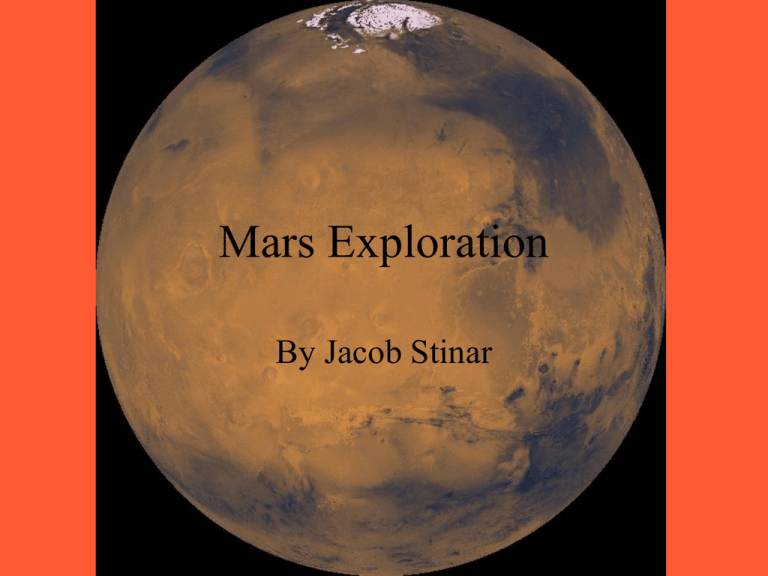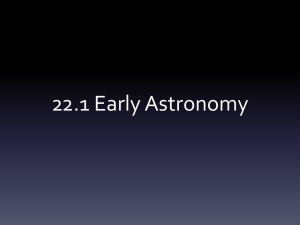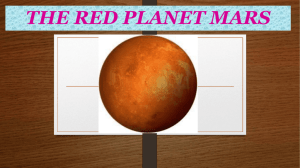Mars
advertisement

Mars Exploration By Jacob Stinar Water on Mars Past, Present, and Future Missions to Mars • early on most missions to Mars failed • 25 missions from 1960-1970 • only 17 missions since http://www.impactlab.com/wp-content/uploads/2009/10/Marsmission-graphic.jpg http://www.nasa.gov/pdf/428154main_Planetary_Science.pdf Mars Exploration Budget http://www.nasa.gov/pdf/428154main_Planetary_Science.pdf Mars Exploration Program Analysis Group (MEPAG) • Broke priorities of Mars exploration into 4 goals: • Life • Climate • Geology • Future Human Exploration Life • Determine if Mars was ever habitable for life or whether habitable environments exist on Mars now • Look for sources and distribution of organic molecules on Mars, mainly carbon. • After finding places where life may be or may have been on Mars go look for that life Climate • Study the Martian atmosphere, present Martian climate, and climate processes on Mars. • Study how the climate on Mars has changed over time. • Examine polar, glacial, and periglacial processes Geological • Examine the geologic processes that have shaped the surface of Mars. • Determine the interior structure and composition of Mars. • Understand the origin, composition, and dynamics of Phobos and Deimos. Future Human Exploration • Gather knowledge about Mars in order to design a safe cost effective mission to Mars • Test the technology to make it safer and less expensive • Study the Martian atmosphere critical for safe operation of the spacecraft Southern Polar Ice Cap • Image taken by the Mars Advanced Radar for Subsurface and Ionospheric Sounding (MARSIS) on the Mars Express Orbiter. • Estimated the water in the Southern Polar Cap would cover the entire surface in 11 meters of water. Mars Reconnaissance Orbiter (MRO) • Went into orbit around Mars in March 2006 • Primary mission was to study the history of water on Mars to see if water was present on Mars for long enough to support life MRO Instruments • HiRise camera which takes high resolution images of selected areas with resolution of 25 centimeters per pixel. • Context Camera (CTX) which takes wide angle images of HiRise image locations • Mars Color Imager (MARCI) monitors clouds and dust storms • CRISM take spectrums in the optical to near-infrared to identify minerals on the surface • MCS detects variations in temperature, dust, and water vapor in the atmosphere • SHARAD uses radar to see water ice is present under the surface. It works from 1 meter down upwards to 1 kilometer down. • Now MRO is also used to relay signals from spacecraft on the surface with it’s large 3 meter antenna and to scout out landing sites for Mars Landers such as Phoenix and Mars Science Laboratory. Mars Exploration Rovers Spirit and Opportunity • Spirit is making preparations for the winter, however it was unable to increase the tilt angle of it’s solar panels toward the Sun. • It may lose contact with the Earth for a few months due to low power. • The rover team programmed Spirit to take images to study winds at the surface and positioned it’s arm to study atmospheric composition when it has enough power. •Opportunity is located near the equator and is not having power issues. Mars Odyssey • Launched in April, 2001 • Main objective is to study the composition Mars’ surface and look for shallow buried ice and water by looking at Hydrogen in the soil • Also serves as a relay communication for Mars’ Landers such as Phoenix. • Listen for Phoenix earlier in the week and heard nothing. Will try again in April. http://www.jpl.nasa.gov/missions/missiondetails.cfm?mission=Odyssey Future Missions: Mars Science Laboratory (MSL) • • • • • Set to launch in fall 2011 Largest most mobile rover yet Can move 90 meters in one day Can drive over obstacles 75 centimeters high Examine samples of Martian soil for climate geological history • Test for building blocks of life Mars Atmosphere and Volatile Evolution Mission (MAVEN) • Set to launch in 2013 • Will study the current loss of atmosphere from Mars to understand it past • Will study the interaction between upper atmosphere and solar wind Questions? Sources http://marsprogram.jpl.nasa.gov/mro/multimedia/images/?ImageID=3180 http://www.uahirise.org/PSP_007338_2640 http://www.nasa.gov/mission_pages/phoenix/images/phx-17072.html http://nowscape.com/star_city/images/sunset_on_mars_PIA07997.jpg http://www.nasa.gov/multimedia/imagegallery/image_feature_347.html http://www.impactlab.com/wp-content/uploads/2009/10/Mars-mission-graphic.jpg http://www.nasa.gov/pdf/428154main_Planetary_Science.pdf http://lasp.colorado.edu/maven/docs/MAVEN_fact_sheet.pdf http://mepag.jpl.nasa.gov/reports/index.html









